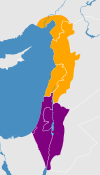North Levantine Arabic
North Levantine Arabic (Arabic: اللهجة الشامية الشمالية, romanized: al-lahja š-šāmiyya š-šamāliyya, North Levantine Arabic: el-lahje š-šāmiyye š-šmāliyye) was defined in the ISO 639-3 international standard for language codes as a distinct Arabic variety, under the apc code. It is also known as Syro-Lebanese Arabic,[1] though that term is also used to mean all of Levantine Arabic.[2]
It was reported by Ethnologue as stemming from the north in Turkey (specifically the coastal regions of the Adana, Hatay, and Mersin provinces)[1][3] to Lebanon,[4][1] passing through the Mediterranean coastal regions of Syria (the Latakia and Tartus governorates) as well as the areas surrounding Aleppo and Damascus.[1][5]
In 2023, South Levantine Arabic and North Levantine Arabic were merged into a single Levantine Arabic,[6] based on the high mutual intelligibility between Arabic varieties spoken by sedentary populations across the Levant and the lack of clear distinctions between variants along national borders.[7]
Dialects
- Syrian Arabic: The dialect of Damascus and the dialect of Aleppo are well-known.[1]
- Lebanese Arabic: North Lebanese, South Lebanese (Metuali, Shii), North-Central Lebanese (Mount Lebanon Arabic), South-Central Lebanese (Druze Arabic), Standard Lebanese, Beqaa, Sunni Beiruti, Saida Sunni, Iqlim-Al-Kharrub Sunni, Jdaideh[1]
- Çukurova, Turkey: Cilician/Çukurovan[1]
References
- ^ a b c d e f g North Levantine Arabic at Ethnologue (25th ed., 2022)

- ^ Versteegh, Kees (2009). Encyclopedia of Arabic language and linguistics. Leiden: Brill. p. 170. ISBN 9789004177024. OCLC 401165899.
- ^ Turkey in Eberhard, David M.; Simons, Gary F.; Fennig, Charles D., eds. (2022). Ethnologue: Languages of the World (25th ed.). Dallas, Texas: SIL International.
- ^ "Glottolog 3.2 - North Levantine Arabic". glottolog.org. Retrieved 2018-07-16.
- ^ Jordan and Syria in Eberhard, David M.; Simons, Gary F.; Fennig, Charles D., eds. (2022). Ethnologue: Languages of the World (25th ed.). Dallas, Texas: SIL International.
- ^ "Glottolog 4.8 - South Levantine Arabic". glottolog.org. Retrieved 2023-11-06.
- ^ "Request for Change to ISO 639-3 Language Code" (PDF). iso639-3.sil.org.
